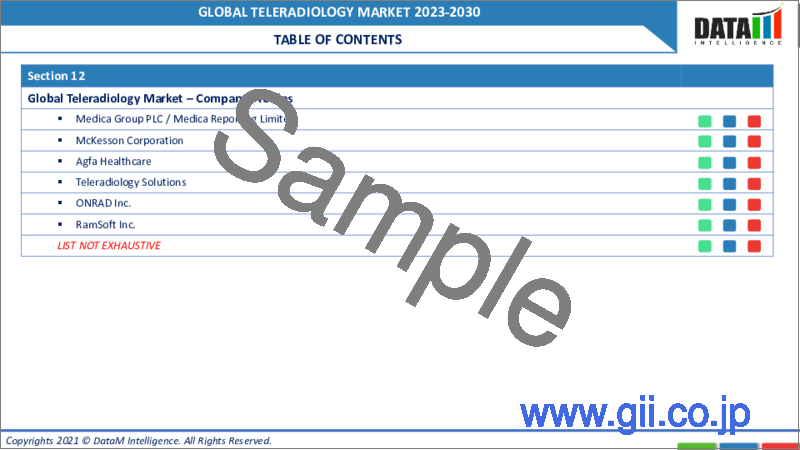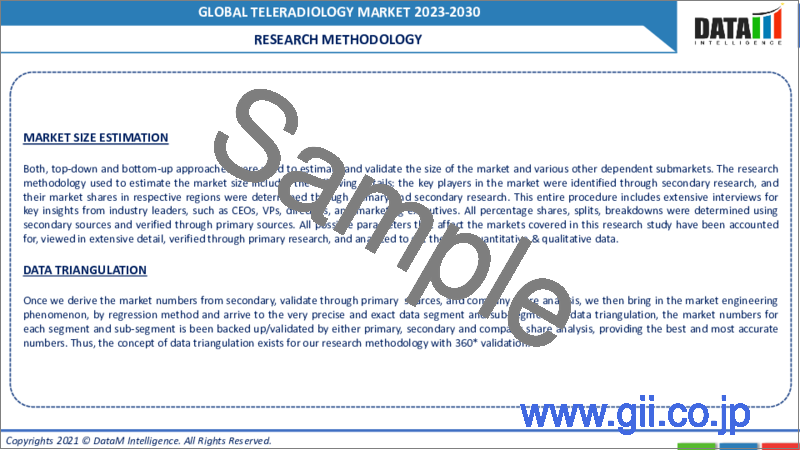|
|
市場調査レポート
商品コード
1138268
テレラジオロジーの世界市場-2022-2029Global Teleradiology Market - 2022-2029 |
||||||
|
● お客様のご希望に応じて、既存データの加工や未掲載情報(例:国別セグメント)の追加などの対応が可能です。 詳細はお問い合わせください。 |
|||||||
| テレラジオロジーの世界市場-2022-2029 |
|
出版日: 2022年10月18日
発行: DataM Intelligence
ページ情報: 英文 180 Pages
納期: 約2営業日
|
- 全表示
- 概要
- 目次
市場力学
テレラジオロジー市場の成長は、放射線サービスに対する需要の増加と熟練した放射線科医の不足によって増強され、有利な政府の取り組みと相まって、次の年の製品需要にかなり拍車をかけます。
放射線サービスに対する需要の高まりと熟練した放射線科医の不足は、予測期間中の製品需要を促進する主要な要因の1つです。
テレラジオロジーは、診断用の医療画像をある場所から別の場所に送信し、医師や放射線技師が簡単にアクセスできるようにするものです。これにより、放射線科医は必ずしも患者と同じ場所にいなくても専門知識を提供することができます。放射線科医の専門分野は少なく、主に先進国や大都市に集中しているため、これは重要なことです。整形外科的損傷やうっ血性心不全などの慢性疾患の高い有病率による放射線サービスの需要の急増は、teleradiology市場の成長を増大させる主要因となっています。遠隔画像診断サービスの採用は、ブラジルやインドなどの多数の発展途上国や、英国、米国、ドイツなどの先進国において、地方と都市の格差の解消に役立っています。また、テレラジオロジー・ソリューションは、出張がなく、放射線科医が遠隔地で仕事ができるため、費用対効果が高く、利便性に優れています。さらに、熟練した有資格の放射線技師が不足していることが、世界の市場の成長をさらに後押ししています。
政府による有利なイニシアチブの導入は、予測期間中の市場成長をさらに促進します。
ヘルスケア情報(HCIT)分野への政府支出の大幅な増加や、デジタル診断への研究・技術革新の導入に向けた市場関係者の注目度の上昇が、製品消費を促進しています。米国の1996年医療保険の相互運用性と説明責任に関する法律などの政府プログラムの出現により、すべての患者データと情報がサイバー犯罪からエンドツーエンドで保護されるようになりました。したがって、国内のすべての遠隔画像診断サービスは、この法律に準拠する必要があります。このような取り組みにより、遠隔画像診断部門に対する患者や医師の信頼が高まり、今後数年間の製品採用率が高まります。オーストラリアと米国では、遠隔画像診断サービスに医療保険が適用されるため、市場の成長がさらに高まります。
米国では診療報酬の削減と規制の強化が市場成長の妨げになる可能性があります。
米国は、テレラジオロジー市場の支配的な国です。しかし、2019年から2021年にかけて、同国では償還額の減少や規制変更の増加が着実に進んでいます。その結果、ヘルスケア産業におけるアライアンスが発生しました。部門に関連する規制手続きが市場の成長を妨げています。2014年のメディケアへのアクセスを保護する法律は、米国でメディケア保険の受益者に提供される高度な画像診断サービスの適切な使用基準(AUC)を設定します。この法律によると、高度な画像診断検査を発注するすべての医療従事者は、臨床判断支援機構(CDSM)を介してAUCを参照する必要があります。このような新興国市場の開拓は、市場の成長を大幅に阻害する可能性があります。
産業分析
テレラジオロジー市場は、ポーターファイブフォース、アンメットニーズ、価格分析、サプライチェーン分析、規制分析など、さまざまな業界要因に基づく市場の詳細な分析を提供します。
COVID-19の影響分析
世界中でCOVID-19が発生したことで、医療従事者には計り知れないプレッシャーがかかり、医療従事者は診断レポートを読み、患者を治療するために遠隔画像診断ソリューションに依存する必要があります。また、遠隔画像診断サービスは、手作業によるエラーを減らし、正しい読影を行うことで放射線治療を簡素化・最適化し、画像診断の効率を高めます。さらに、画像診断結果のハードコピーを交換したり、直接連絡を取り合ったりする手間を省くことができます。さらに、放射線科医による世界規模のさまざまなテレラジオロジー・パートナーシップが、臨床試験や予防措置の研究を加速させると予測されています。さらに、当初は、選択的画像診断サービスのロックアウトとホールドにより、テレラジオロジーサービスが減少していました。しかし、予測期間には、選択的外科手術サービスの状況は徐々に改善されると予想されます。
当レポートでは、世界のテレラジオロジー市場について、約45以上の市場データ表、40以上の図表、180ページのアクセスを提供することになります。
目次
第1章 調査手法と調査範囲
- 調査手法
- 調査目的および調査範囲
第2章 市場の定義と概要
第3章 エグゼクティブサマリー
第4章 市場の力学
- 市場影響要因
- 促進要因
- 放射線サービスに対する需要の高まりと熟練した放射線技師の不足が、予測期間中の製品需要を促進する主要因の1つとなっています。
- 政府別有利なイニシアチブの導入は、予測期間中の市場成長をさらに後押しします。
- 抑制要因
- 米国における診療報酬の削減と規制の強化が、市場成長の妨げとなる可能性があります。
- 機会
- 影響分析
- 促進要因
第5章 産業分析
- ポーターの5つの力
- アンメットニーズ
- サプライチェーン
- プライシング分析
- 規制分析
第6章 COVID-19の分析
- COVID-19の市場分析
- COVID-19以前の市場シナリオ
- COVID-19の現在の市場シナリオ
- COVID-19の後、または将来のシナリオ
- COVID-19の中での価格ダイナミクス
- 需要-供給スペクトラム
- パンデミック時の市場に関連する政府の取り組み
- メーカーの戦略的な取り組み
- まとめ
第7章 製品・サービス別
- ハードウェア
- ソフトウェア
- 画像保管・通信システム
- 放射線情報システム
- サービス
第8章 画像技術別
- コンピュータ断層撮影
- 磁気共鳴画像
- 超音波診断装置
- X線
- マンモグラフィー
- 核医学画像診断
- 蛍光透視法
第9章 アプリケーション別
- 遠隔診断
- 遠隔コンサルティング
- 遠隔モニタリング
第10章 エンドユーザー別
- 病院
- 外来手術センター
- 診断センター
- 放射線クリニック
- その他
第11章 地域別
- 北米
- 米国
- カナダ
- メキシコ
- 欧州
- ドイツ
- 英国
- フランス
- イタリア
- スペイン
- その他欧州
- 南米
- ブラジル
- アルゼンチン
- その他の南米地域
- アジア太平洋地域
- 中国
- インド
- 日本
- オーストラリア
- その他アジア太平洋地域
- 中東・アフリカ地域
第12章 競合情勢
- 競合シナリオ
- 市況/シェア分析
- M&A(合併・買収)分析
第13章 企業プロファイル
- Philips healthcare
- 企業概要
- 製品ポートフォリオと説明
- 主なハイライト
- 財務概要
- Cerner Corporation
- Siemens Healthineers
- McKesson Corporation
- FUJIFILM Holdings Corporation
- Agfa Healthcare
- MEDNAX Services, Inc.
- ONRAD Inc.
- RamSoft Inc.
- Novarad Corporation
- TeleDiagnostic Solutions Pvt. Ltd.
- Teleradiology Solutions
- Telerad Tech
- StatRad LLC
第14章 世界のテレラジオロジー市場-DataM
Market Overview
Teleradiology Market is expected to reach a high CAGR of 18.85% during the forecasting period (2022-2029). Teleradiology comes under telemedicine, which involves transmitting radiological patient images, including CTs, X-rays, and MRIs, from one location to another for consulting and diagnostic purposes. It is a modern technology developed due to the imbalance between demand and availability of diagnostic services. It provides enhanced on-site solutions through global cloud networks and real-time interpretation.
The Teleradiology Market study analysis offers an in-depth outlook on the market containing both quantitative, and qualitative data. It gives an outlook and forecast of the global market based on the Teleradiology Market segmentation by product type, technology, and application. It also provides Teleradiology Market size, and growth, along with the latest trends, opportunities, and forecast till 2029 for the global market with esteem to major countries such as the United States, Canada, Brazil, Germany, Italy, Spain, United Kingdom, Russia, European countries, United Arab Emirates, Saudi Arabia, South Africa, Japan, China, India, South Korea, Australia, and rest of the countries over the globe.
Market Dynamics
Teleradiology Market growth is augmented by increasing demand for radiology services & a shortage of skilled radiologists coupled with favorable government initiatives will considerably spur the product demand in the following years.
The rising demand for radiology services and a lack of skilled radiologists is one of the prime factors driving product demand in the forecast period.
Teleradiology helps transmit diagnostic medical images from one place to another, where physicians and radiologists can easily access them. It allows radiologists to provide their expertise without necessarily being in the same place as the patient. This is important because radiologist subspecialties are less in number and are mainly located in developed and metropolitan cities. The surge in demand for radiological services due to the high prevalence of chronic diseases such as orthopedic injuries and congestive heart failure are the key factors augmenting the growth of the teleradiology market. The adoption of teleradiology services has helped bridge the rural and urban disparity in numerous developing countries such as Brazil and India and developed countries, including the U.K., the U.S., and Germany. Also, teleradiology solutions are more cost-effective and convenient as they eliminate travel and allow radiologists to work remotely. In addition, a shortage of skilled and qualified radiologists has further driven market growth worldwide.
The introduction of favorable government initiatives further drives the market growth during the forecast period.
A substantial increase in government expenditure on the healthcare information (HCIT) sector and a rise in focus on market players towards bringing research and innovation to digital diagnostics proliferates product consumption. The advent of government programs such as the Health Insurance Portability and Accountability Act of 1996 in the U.S. enables all patient data and information to have end-to-end protection from cybercrimes. Therefore, all the teleradiology services in the country must comply with this act. These initiatives build trust and improve patient and physician confidence in the teleradiology sector, thus increasing the coming years' product adoption rate. The availability of healthcare coverage for teleradiology services in Australia and the U.S. further strengthens the market growth.
Reducing reimbursements and increasing the regulatory burden in the US is likely to hamper the market growth.
The US is the dominating country in the teleradiology market. However, from 2019 to 2021, the country experienced a steady decline in reimbursements and a rise in regulatory changes in the US. This resulted in an alliance in the healthcare industry. The regulatory procedures associated with the sector are hindering the market growth. The Protecting Access to Medicare Act of 2014 sets appropriate use criteria (AUC) for advanced diagnostic imaging services offered to Medicare insurance beneficiaries in the US. According to this act, every medical professional who orders an advanced diagnostic imaging test must consult the AUC via a clinical decision support mechanism (CDSM). These developments can substantially hamper the market growth.
Industry Analysis
The teleradiology market provides in-depth analysis of the market based on various industry factors such as porter five forces, unmet needs, pricing analysis, supply chain analysis, regulatory analysis etc.
COVID-19 Impact Analysis
The outbreak of COVID-19 across the globe has put immense pressure on medical practitioners, and healthcare professionals need to rely on teleradiology solutions to read diagnostic reports and treat patients. Teleradiology services also enhance the efficiency of diagnostic imaging by simplifying and optimizing radiology with reduced manual errors and correct readings. Moreover, it helps avoid exchanging hard copies of imaging results and in-person contacts. In addition, various worldwide teleradiology partnerships of radiologists are projected to accelerate clinical trials and preventative measures research. Furthermore, there was initially a decline in teleradiology services due to the lockout and hold on elective imaging services. However, the situation for elective surgical services is expected to improve gradually in the forecast period.
Segment Analysis
The software segment is the fastest-growing segment and is expected to register the highest CAGR during the forecast period (2022-2029).
The software segment is expected to gain popularity in the coming years. The growing demand for healthcare software has spurred companies to enhance interoperability, increase the data transparency, and improve technical capabilities. Furthermore, the coronavirus outbreak has increased the need to manage large amounts of patient data better. Due to this, many hospitals are adopting teleradiology solutions to enhance healthcare providers' efficiency and improve patient outcomes. Moreover, technological advancements in software and product launches by the key market players are the other factors driving the market in the forecast period. For instance, the use of a smartphone-based digital camera for mobile teleradiology. Physicians typically use their smartphones to collect photographs, and substantial developments in recent years have enabled smartphones to capture and transmit high-resolution images in jpeg, png, or gif file formats. They could be converted to Digital Imaging and Communications in Medicine (DICOM) if needed for storage in a PACS but without any embedded data. Furthermore, GE Healthcare (US) released a cloud-based Edison True PACS in August 2021, which includes revolutionary and AI-enabled decision-making technologies to help improve reading speed, minimize errors, improve diagnostic precision, and enable confident diagnoses. Therefore, it has increased the demand for software and accounted for the largest market share in the forecast period.
Geographical Analysis
North America registered the highest CAGR in the teleradiology market during the forecast period.
The increasing prevalence of chronic diseases, technological advancements in teleradiology, FDA approvals of products, developed infrastructure, supportive government initiatives, and increasing demand for efficient teleradiology solutions in the region are the factors the market is expected to be driven by in the forecast period. For instance, teleradiology has witnessed a surge in the aftermath of the COVID-19 epidemic. However, minimizing risks and hurdles in this sector is critical to realizing its full potential to improve patient care. The fast availability of diagnostic services, critical during medical emergencies, and the imbalance between the high demand for radiology services and the available ratio of healthcare professionals, necessitates adapting services such as teleradiology. Moreover, the COVID epidemic was the greatest testimonial to teleradiology and its importance. Teleradiology, like other health tech options at the time, became a practical delivery mode and found widespread use. Given the limited availability and time required for lab examinations, radiography and teleradiology played an important role in restricting the spread of the virus in the early epidemic. In a few instances, radiological investigation was the only choice for screening. The unexpected surge increased demand for teleradiology services by approximately 150% across the country, particularly for CT chest and X-ray reports. During this time, many teleradiology services developed and were able to meet this unique COVID demand. Artificial intelligence aided in real-time COVID screening and reduced radiologist burnout caused by this abrupt surge.
Furthermore, Nines announced the 510(k) FDA clearance for NinesMeasure, a new lung nodule measurement instrument that aids in the diagnosis of certain respiratory disorders, in March 2021. Thus, from the above statements, the North American region accounted for the largest market share in the forecast period.
Competitive Landscape
Major key players in the teleradiology market are Koninklijke Philips N.V., MEDNAX Services, Inc., Teleradiology Solutions, Carestream Health, ONRAD, Inc., USARAD Holdings Inc., and Cerner Corporation, among others.
Koninklijke Philips N.V. (Philips Healthcare):
Overview:
Koninklijke Philips N.V. is a Dutch multinational conglomerate corporation. Philips was formerly one of the largest electronics companies globally, currently focused on health technology, with other divisions being divested. Philips is organized into three main divisions: Personal Health (formerly Philips Consumer Electronics and Philips Domestic Appliances and Personal Care), Connected Care, and Diagnosis Treatment (formerly Philips Medical Systems). It currently employs around 80,000 people across 100 countries.
Product Portfolio:
Philips' new telehealth services build on its cloud-based radiology informatics portfolio of Picture Archiving and Communication Systems (PACS) and Vendor Neutral Archive (VNA) solutions, combined with advanced analytics, visualization and workflow applications, to now also include advanced teleradiology viewing and reporting capabilities, on-call radiologist services, and related exam workflow enhancement applications. Teleradiology involves the remote interpretation of patient images from medical imaging exams, such as CT, MR, and X-ray exams, by radiologists without needing them to be in the same location as the patient.
The global teleradiology market report would provide an access to an approx. 45+market data table, 40+figures and 180pages.
Table of Contents
1. Methodology and Scope
- 1.1. Research Methodology
- 1.2. Research Objective and Scope of the Report
2. Market Definition and Overview
3. Executive Summary
4. Market Dynamics
- 4.1. Market Impacting Factors
- 4.1.1. Drivers
- 4.1.1.1. The rising demand for radiology services and a lack of skilled radiologists is one of the prime factors driving product demand in the forecast period.
- 4.1.1.2. The introduction of favorable government initiatives further drives the market growth during the forecast period.
- 4.1.2. Restraints:
- 4.1.2.1. Reducing reimbursements and increasing the regulatory burden in the US is likely to hamper the market growth.
- 4.1.3. Opportunity
- 4.1.4. Impact Analysis
- 4.1.1. Drivers
5. Industry Analysis
- 5.1. Porter's Five Forces
- 5.2. Unmet Needs
- 5.3. Supply Chain
- 5.4. Pricing Analysis
- 5.5. Regulatory Analysis
6. COVID-19 Analysis
- 6.1. Analysis of Covid-19 on the Market
- 6.1.1. Before COVID-19 Market Scenario
- 6.1.2. Present COVID-19 Market Scenario
- 6.1.3. After COVID-19 or Future Scenario
- 6.2. Pricing Dynamics Amid Covid-19
- 6.3. Demand-Supply Spectrum
- 6.4. Government Initiatives Related to the Market During Pandemic
- 6.5. Manufacturers Strategic Initiatives
- 6.6. Conclusion
7. By Products & Services
- 7.1. Introduction
- 7.1.1. Market Size Analysis, and Y-o-Y Growth Analysis (%), By Products & Services
- 7.1.2. Market Attractiveness Index, By Products & Services Segment
- 7.2. Hardware*
- 7.2.1.1. Introduction
- 7.2.1.2. Market Size Analysis, US$ Million, 2020-2029 and Y-o-Y Growth Analysis (%), 2021-2029
- 7.3. Software
- 7.3.1. Picture archiving & communication systems
- 7.3.2. Radiology information systems
- 7.4. Services
8. By Imaging Techniques
- 8.1. Introduction
- 8.1.1. Market Size Analysis, and Y-o-Y Growth Analysis (%), By Imaging Techniques
- 8.1.2. Market Attractiveness Index, By Imaging Techniques Segment
- 8.2. Computed Tomography*
- 8.2.1. Introduction
- 8.2.2. Market Size Analysis, US$ Million, 2020-2029 and Y-o-Y Growth Analysis (%), 2021-2029
- 8.3. Magnetic Resonance Imaging
- 8.4. Ultrasound
- 8.5. X-Ray
- 8.6. Mammography
- 8.7. Nuclear Imaging
- 8.8. Fluoroscopy
9. By Application
- 9.1. Introduction
- 9.1.1. Market Size Analysis, and Y-o-Y Growth Analysis (%), By Application
- 9.1.2. Market Attractiveness Index, By Application Segment
- 9.2. Tele diagnosis*
- 9.2.1. Introduction
- 9.2.2. Market Size Analysis, US$ Million, 2020-2029 and Y-o-Y Growth Analysis (%), 2021-2029
- 9.3. Tele consultation
- 9.4. Tele monitoring
10. By End user
- 10.1. Introduction
- 10.1.1. Market Size Analysis, and Y-o-Y Growth Analysis (%), By End user
- 10.1.2. Market Attractiveness Index, By End user Segment
- 10.2. Hospitals*
- 10.2.1. Introduction
- 10.2.2. Market Size Analysis, US$ Million, 2020-2029 and Y-o-Y Growth Analysis (%), 2021-2029
- 10.3. Ambulatory Surgical Centers
- 10.4. Diagnostic Centers
- 10.5. Radiology Clinics
- 10.6. Others
11. By Region
- 11.1. Introduction
- 11.1.1. Market Size Analysis, US$ Million, 2020-2029 and Y-o-Y Growth Analysis (%), 2021-2029, By Region
- 11.1.2. Market Attractiveness Index, By Region
- 11.2. North America
- 11.2.1. Introduction
- 11.2.2. Key Region-Specific Dynamics
- 11.2.3. Market Size Analysis, and Y-o-Y Growth Analysis (%), By Product & Services
- 11.2.4. Market Size Analysis, and Y-o-Y Growth Analysis (%), By Imaging Techniques
- 11.2.5. Market Size Analysis, and Y-o-Y Growth Analysis (%), By Application
- 11.2.6. Market Size Analysis, and Y-o-Y Growth Analysis (%), By End user
- 11.2.7. Market Size Analysis, and Y-o-Y Growth Analysis (%), By Country
- 11.2.7.1. U.S.
- 11.2.7.2. Canada
- 11.2.7.3. Mexico
- 11.3. Europe
- 11.3.1. Introduction
- 11.3.2. Key Region-Specific Dynamics
- 11.3.3. Market Size Analysis, and Y-o-Y Growth Analysis (%), By Products & Services
- 11.3.4. Market Size Analysis, and Y-o-Y Growth Analysis (%), By Imaging techniques
- 11.3.5. Market Size Analysis, and Y-o-Y Growth Analysis (%), By Application
- 11.3.6. Market Size Analysis, and Y-o-Y Growth Analysis (%), By End user
- 11.3.7. Market Size Analysis, and Y-o-Y Growth Analysis (%), By Country
- 11.3.7.1. Germany
- 11.3.7.2. U.K.
- 11.3.7.3. France
- 11.3.7.4. Italy
- 11.3.7.5. Spain
- 11.3.7.6. Rest of Europe
- 11.4. South America
- 11.4.1. Introduction
- 11.4.2. Key Region-Specific Dynamics
- 11.4.3. Market Size Analysis, and Y-o-Y Growth Analysis (%), By Products & Services
- 11.4.4. Market Size Analysis, and Y-o-Y Growth Analysis (%), By Imaging Techniques
- 11.4.5. Market Size Analysis, and Y-o-Y Growth Analysis (%), By Application
- 11.4.6. Market Size Analysis, and Y-o-Y Growth Analysis (%), By End user
- 11.4.7. Market Size Analysis, and Y-o-Y Growth Analysis (%), By Country
- 11.4.7.1. Brazil
- 11.4.7.2. Argentina
- 11.4.7.3. Rest of South America
- 11.5. Asia Pacific
- 11.5.1. Introduction
- 11.5.2. Key Region-Specific Dynamics
- 11.5.3. Market Size Analysis, and Y-o-Y Growth Analysis (%), By Products & Services
- 11.5.4. Market Size Analysis, and Y-o-Y Growth Analysis (%), By Imaging Techniques
- 11.5.5. Market Size Analysis, and Y-o-Y Growth Analysis (%), By Application
- 11.5.6. Market Size Analysis, and Y-o-Y Growth Analysis (%), By End user
- 11.5.7. Market Size Analysis, and Y-o-Y Growth Analysis (%), By Country
- 11.5.7.1. China
- 11.5.7.2. India
- 11.5.7.3. Japan
- 11.5.7.4. Australia
- 11.5.7.5. Rest of Asia Pacific
- 11.6. Middle East and Africa
- 11.6.1. Introduction
- 11.6.2. Key Region-Specific Dynamics
- 11.6.3. Market Size Analysis, and Y-o-Y Growth Analysis (%), By Products & Services
- 11.6.4. Market Size Analysis, and Y-o-Y Growth Analysis (%), By Imaging Techniques
- 11.6.5. Market Size Analysis, and Y-o-Y Growth Analysis (%), By Application
- 11.6.6. Market Size Analysis, and Y-o-Y Growth Analysis (%), By End user
12. Competitive Landscape
- 12.1. Competitive Scenario
- 12.2. Market Positioning/Share Analysis
- 12.3. Mergers and Acquisitions Analysis
13. Company Profiles
- 13.1. Philips healthcare*
- 13.1.1. Company Overview
- 13.1.2. Product Portfolio and Description
- 13.1.3. Key Highlights
- 13.1.4. Financial Overview
- 13.2. Cerner Corporation
- 13.3. Siemens Healthineers
- 13.4. McKesson Corporation
- 13.5. FUJIFILM Holdings Corporation
- 13.6. Agfa Healthcare
- 13.7. MEDNAX Services, Inc.
- 13.8. ONRAD Inc.
- 13.9. RamSoft Inc.
- 13.10. Novarad Corporation
- 13.11. TeleDiagnostic Solutions Pvt. Ltd.
- 13.12. Teleradiology Solutions
- 13.13. Telerad Tech
- 13.14. StatRad LLC
LIST NOT EXHAUSTIVE
14. Global Teleradiology Market - DataM
- 14.1. Appendix
- 14.2. About Us and Applications
- 14.3. Contact Us




